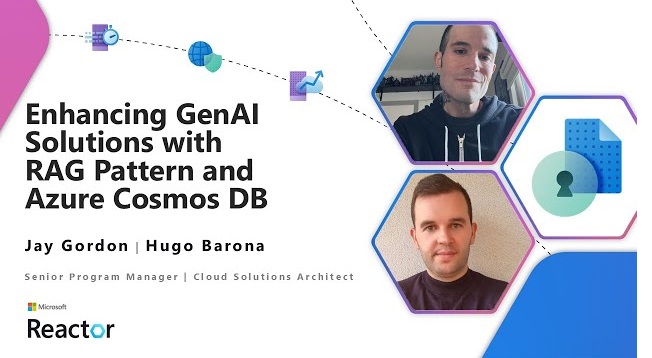Enhancing GenAI Solutions with RAG Pattern and Azure Cosmos DB - Oct. 2024

Summary
In October 2024, I had the incredible opportunity to co-host the Azure Cosmos DB Global User Group live stream alongside Jay Gordon. During this session, we explored some of the most exciting updates to Azure Cosmos DB, focusing on its enhanced Autoscale feature and how it integrates seamlessly with advanced methodologies for generative AI applications. One of the key highlights I shared was the introduction of a dynamic scaling feature that allows throughput to scale independently per partition and region. This innovation is a game-changer for global applications with variable traffic patterns, offering significant cost efficiency.
I also had the chance to dive deep into the retrieval-augmented generation (RAG) pattern, showcasing how it can be integrated with Azure tools to enhance application performance. As someone passionate about AI, I shared insights into the evolution of AI technologies, from traditional keyword search to modern vector search methods. Vector search, in particular, is a revolutionary approach that improves relevance and accuracy in AI applications by identifying semantic similarities in content.
The session was highly interactive, and I thoroughly enjoyed engaging with the audience in a respectful and professional environment. Together, we explored a hands-on demonstration of implementing the RAG pattern using Azure Cosmos DB, Azure AI Search, and Azure OpenAI. My goal was to show developers and data scientists how they can build robust generative AI applications without the need for extensive retraining of existing models.
During the live demo, I walked participants through setting up a new container in Azure Cosmos DB using Jupyter Notebook. We configured essential parameters, installed key Python libraries, and created embeddings from text datasets. I emphasized the importance of correctly configuring vector fields and embedding policies to unlock the full potential of Azure AI Search for effective search capabilities.
The session concluded with a lively Q&A segment where we tackled advanced topics like leveraging multi-head RAG models and data consolidation techniques. It was inspiring to see the level of curiosity and engagement from the audience, and I’m excited to continue fostering this collaborative spirit in future events.
Highlights
- 🚀 Dynamic Scaling: Azure Cosmos DB can now independently scale throughput per partition and region for improved cost-efficiency.
- 🌟 RAG Pattern: Introduction of retrieval-augmented generation pattern enhances the performance of applications using Azure tools.
- 🔍 Vector vs. Keyword Search: Transitioning from traditional keyword searches to vector searches improves relevance and accuracy of AI application outputs.
- 💻 Hands-on Demonstration: Live demo showcasing the setup of RAG using Azure services, which aids developers in creating generative AI solutions.
- 📊 Embedding Configurations: Importance of proper vector field configuration to enhance the capabilities of Azure AI search.
- 🌐 Real-world Applications: Practical implications demonstrate how Azure Cosmos DB can serve diverse application needs through advanced search capabilities.
- 🎤 Engaging Q&A: Active participant engagement allowed for deeper exploration into multi-head RAG models and data processing techniques.
Key Insights
-
📈 Dynamic Scaling for Cost Efficiency: The new dynamic scaling feature allows Azure Cosmos DB to adjust resources finely based on individual partition and regional needs. This is crucial for applications with fluctuating workloads and can lead to significant cost savings by only using resources as needed.
-
🤖 Evolution of AI Technologies: Hugo Barona’s insights into the historical context of AI technologies reveal that current advancements, driven by LLMs and generative AI, have been years in the making. Understanding this evolution helps contextualize current trends and applications in the field.
-
📊 Benefits of Vector Search: The move from traditional keyword-based searches to vector searches offers higher accuracy and context relevance in result generation. Vector searches work by identifying semantic similarities between content, making them more suitable for AI applications where context matters.
-
🛠️ Effective Implementation of RAG: The session’s demonstration provided real-world insights into how developers can leverage existing Azure infrastructures to implement the RAG pattern, removing barriers to entry for less experienced developers while fostering creative uses of AI technologies.
-
🔗 Seamless Integration: The ability to effectively integrate Azure Cosmos DB and Azure AI Search maximizes the potential of generative AI applications. Proper embedding configurations play a pivotal role in enhancing search accuracy and relevance, thus improving overall user experience.
-
🎓 Learning Opportunities: The interactive format of the session encouraged a culture of learning and knowledge sharing, enabling attendees to ask questions and take away actionable insights that they could apply directly in their projects.
-
🌍 Future Engagement and Collaboration: The conclusion of the session with a focus on future participation highlights the community aspect of the Azure Cosmos DB platform and the importance of collaborative learning in the tech space, encouraging ongoing engagement and knowledge sharing among users.
This session was a fantastic opportunity to share my knowledge and passion for AI and Azure services. I’m incredibly grateful for the chance to connect with such a vibrant community of developers and data scientists. If you missed the live stream, I highly encourage you to watch the recording to learn more about how Azure Cosmos DB and Azure AI services can transform your generative AI applications.
🫶 If you find this blog post useful, please share it to support my work 🫶
